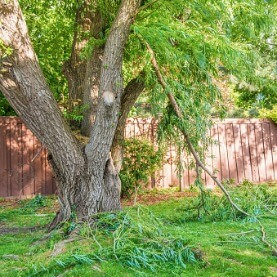
5 Ways To Protect Your Lawn & Garden From Summer Storms
Jun 06th 2019
It takes only minutes for summer storms to develop in North Central Florida. As the skies darken and distant thunder rumbles, and people seek shelter, their landscaping is left exposed to the elements. Strong winds and heavy rains can damage flowers, plants, and trees, while floods can wash away landscaping features. But you don’t have to sit idly by watching this destruction. Evergreen Lawn Care lays out five ways to stormproof a lawn.
1. Remove Dead Branches & Debris
Dead or decaying tree limbs pose an inherent falling danger, but storm conditions further increase the risks of damage to your property, including the landscaping — gardens and flower beds are no match against falling branches. Even after they’ve reached the ground (or have been left over from past storms), dead branches and similar debris can be swept up by the wind or water runoff and thrown into other landscape features, where the debris causes damage and creates a mess. Debris removal is recommended soon after storms, but also prior to hurricanes, tornadoes, tropical storms and other large storms.
2. Lay Mulch Around Flowers
That premium topsoil in your garden that you bought and carefully enriched with nutrient-rich matter from a compost pile can all be washed away in seconds by storm flooding. But you can protect soil with garden mulch. A 3-inch to 4-inch blanket of mulch not only keeps soil favorably cool and moist for plant growth during summer, but it also acts as a protective barrier; it’s ultimately cheaper and less harmful to plants for a lawn to lose a bit of mulch as opposed to a lot of soil. Mulch also comes in multiple designs, including organic (pine bark, cypress), inorganic (rubber), and mulch alternatives, such as river rocks.
3. Have A Drainage Plan For Water
Rainwater needs someplace to go once it’s on the ground. Having a drainage plan ensures the water flows away from your landscaping and into ditches, streams, or underground drains. Water without a place to drain can accumulate in puddles, which saturate the soil and choke off oxygen to plant life. Stormwater could also drain in wrong directions and even wash away the mulch, soil, and other loose features of landscaping. Most professionally designed lawns have built-in drainage plans. But if your home has problems from stormwater, contact Gainesville landscapers about possible drainage solutions.
4. Store Landscaping Equipment
Without your gardening and lawn care tools, there’d be no landscaping to protect from storms. Equipment such as lawn mowers, hedge trimmers, rakes and shovels, and even gardening gloves are susceptible to weathering. To ensure these landscaping tools remain functional, it’s best to store such equipment in a garden shed or home garage between uses.
5. Cover New Plants
Flowers, garden plants, and sapling trees are among the most fragile parts of landscaping and thus the most at-risk for storm damage. Covering plants with row covers — makeshift shelters composed of PVC pipe arches placed over plants and covered by spunbond materials, tarps, or frost blankets — is one way to protect them from direct exposure to harsh conditions. If trees are too tall for row covers, knocking two or three stakes into the ground and tying them to the tree with rope helps protect the tree against bends or breaks during strong winds.
No matter what the weather is like this summer, these stormproof tips will help preserve landscaping in North Central Florida. Our team provides landscaping services in Gainesville, including storm-related clean-up such as debris removal, irrigation repairs, and garden mulching. Give us a call today!
